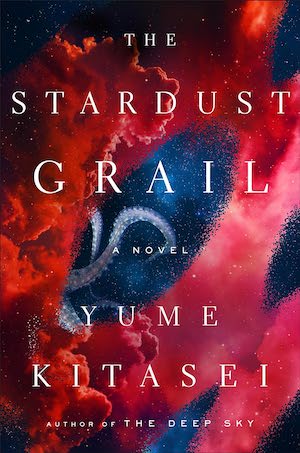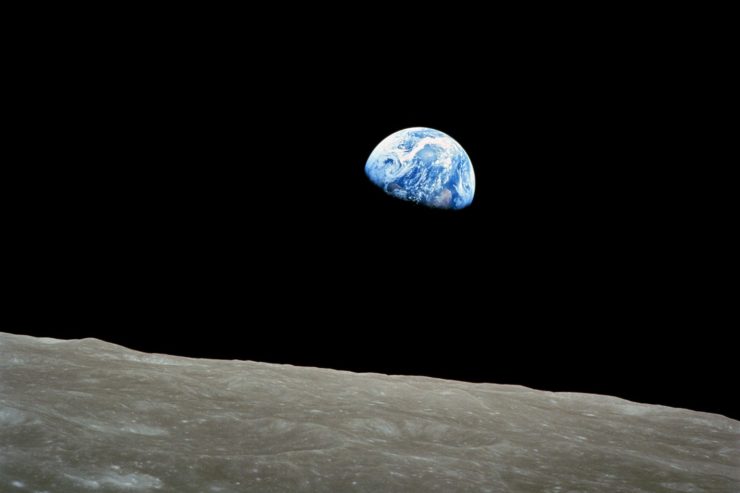We’re in a new golden age of “compassionate” science fiction—stories that are hopeful, cozy, or just feel-good about finding your people, overcoming terrible things, and bridging differences. These books are not utopian, but rather understand that while the universe can be a struggle, you don’t have to do it alone. Which is incredibly comforting to remember when you’re stricken with anxiety: these stories are a balm when we live in a dumpster fire. We all want more of whatever Becky Chambers is serving, and the comps used for newly released books (including mine) reference her books fervently for a reason.
But compassionate science fiction isn’t a passing fad. The elements that seem “new” are natural and traditional themes in space opera: found family, empathy, and hope that reason and love will win the day. There are a few things about the context of space itself that are conducive to nurturing these ideas.
Space is vast, and on that scale there’s little difference between you and an atom of carbon. But when you’re traveling through space, your scale of reference is a spaceship, and those are relatively small. Because of that, space stories are inherently intimate. In close quarters, you have to actually talk to the people you’re in that small space with—cue Martha Wells’ Murderbot complaining bitterly about having to interact with humans (and ship computer bestie, ART, turned BFF) instead of binge-watching dramas. You may get on each other’s nerves, but you’re stuck, so you’ll have to work through that, because often it could be weeks or months or even years to get where you’re going.
This theme is usually amplified by the fact that the main characters are usually a group of disparate people who are forced to travel in the same direction on a journey of shared wonder or a mission of high stakes.
In stories where Earth is involved, the cast is usually as multi-national as the International Space Station. In the Victories Greater Than Death trilogy by Charlie Jane Anders, a rambunctious and joyous, thrill-ride, ax motley crew of young people from all over the world reminiscent of one of my favorite childhood TV shows, Captain Planet (except they wield STEM genius rather than super powers) are recruited from Earth to take on an evil, mass murdering force called “The Compassion,” (which gets the prize for best name for a villainous group), who are waging a xenocidal campaign. There’s Tina Mains, the clone of a famous alien general; her best friend Rachel, an artist; Elza, a hacker; Yiwei, a robotics engineer; Keziah, a physics whizz; and Damini, a mathematician turned pilot. Each character has different flaws and desires, but only together can they overcome the great threat to life in the galaxy.
On the other end of the science fiction spectrum, you can read the deliciously complex and cerebral Red Mars trilogy by Kim Stanley Robinson, which features a carefully selected group of a hundred multi-national colonists (in 2026, by the way) who set out to transform the red planet into another Earth. The stories are very different, but in both cases, the the drama plays out on both an intimate and international or galactic scale, and the characters overcome diverse backgrounds to come together to achieve something huge.
These themes stay true when characters originate from multiple planets, with crew who originate from different parts of the system that don’t get along, as with the crew of The Rocinante in The Expanse by S. A. Corey. In this story, the reluctant Captain and former UN officer from Earth, “Belter” ship engineers and mechanics from the asteroid belts, and an ex-Martian Navy pilot. Through the mounting political tension between their places of origin, the crew debates and finds common cause—the survival of the human race. The ship makes an effective stage for the broader system’s disagreements—and offers a glimmer of hope even as the broader system goes to war—that peace and collaboration is possible.
In other cases, the characters are from even farther afield from each other, as in Chilling Effect by Valerie Valdes, made up of human, enhanced human, telepathic feline, and otherwise alien crew of the La Sirena Negra, who would die for each other even when they’re clearly working through communication problems that are bound to undermine trust.
Across these stories, the crews work together at first because they have too: each member comes with skills that the others need for the mission. Sometimes the skills are less immediately obvious in their application, as in in Adrian Tchaikovsky’s Shards of Earth, whose Vulture crew includes characters with such exotic skills as accountant and lawyer. Other times, the crew roles are more traditional space opera, as in, yes, the Long Way to a Small Angry Planet by Becky Chambers: captain, pilot, mechanic, computer technician, doctor, cook, and clerk. Ultimately, it’s this need that generally becomes the foundation each time for overcoming their differences and achieving what would have been impossible alone.
This common theme is born in the sense that once you get beyond the Earth, the lines we’ve drawn between us are impossible to see. Nationalism may have propelled us into space, but when astronauts turned around and photographed the planet from the moon, the picture they captured (seen above), “Earthrise” spurred an environmental movement: a singular, small blue-green ball that we all have to share for better or worse. There’s even a term for a cognitive shift that happens when people go to space: the overview effect, a certain state of awe that can alter the way people fundamentally perceive themselves, their connection to others, and the larger world. Space opera is imbued with this spirit.
Which is why found family abounds. The thing is, maybe you don’t matter in the grand context of the universe, but you matter to other people, and you’re not alone. You’re not one atom, you’re you and everyone who occupies the small Firefly you’re flying through space with. It’s one of the things I love about Star Wars: everyone has different reasons for being there, but in the end, they will risk their lives to save one another, even if they would not have been friends in another context.
This is one of the reasons I’m drawn to the genre: my parents were born halfway around the world from each other, and even as a child, I was aware of how my own existence was predicated on the very large historical events (many of them ugly) that needed to happen in a particular way for these two people from different backgrounds to meet. In space opera, the characters travel to distant places and are exposed to different cultures and perspectives. They are forced to reevaluate their own deeply held views in the process and grow as people. Star Trek is, of course, the classic example of this. In each iteration, a Starfleet crew voyages out into the dark with the explicit goal of finding new people, and what they most often find are strange reflections of themselves that expand their understanding of life in the universe.
Even in space operas where learning is not the explicit goal, it’s still always a possibility. In Project Hail Mary by Andy Weir, an alien threat forces humanity to journey to a distant star for salvation – and let’s just say, it’s not just the destination but the friends you make along the way. In Kemi Ashing-Giwa’s The Splinter in the Sky, the main character is forced to travel to another planet – she meets some pretty terrible people but finds a friend and ally too in a place she least expects.
These themes are what make space opera feel attractive and even ‘cozy’ during the tumult of current times. We’re trapped in the horrors of history, and many of us have spent so much of recent years cooped up in our pandemic-induced bubbles trying to navigate the uncertain world from claustrophobic confines. So while none of these elements are new in space opera, it’s exactly what we need right now. We read these stories with the hope that some other destination beyond our present, dark trajectory is possible. And for a few hours, we find it.
Buy the Book


The Stardust Grail










